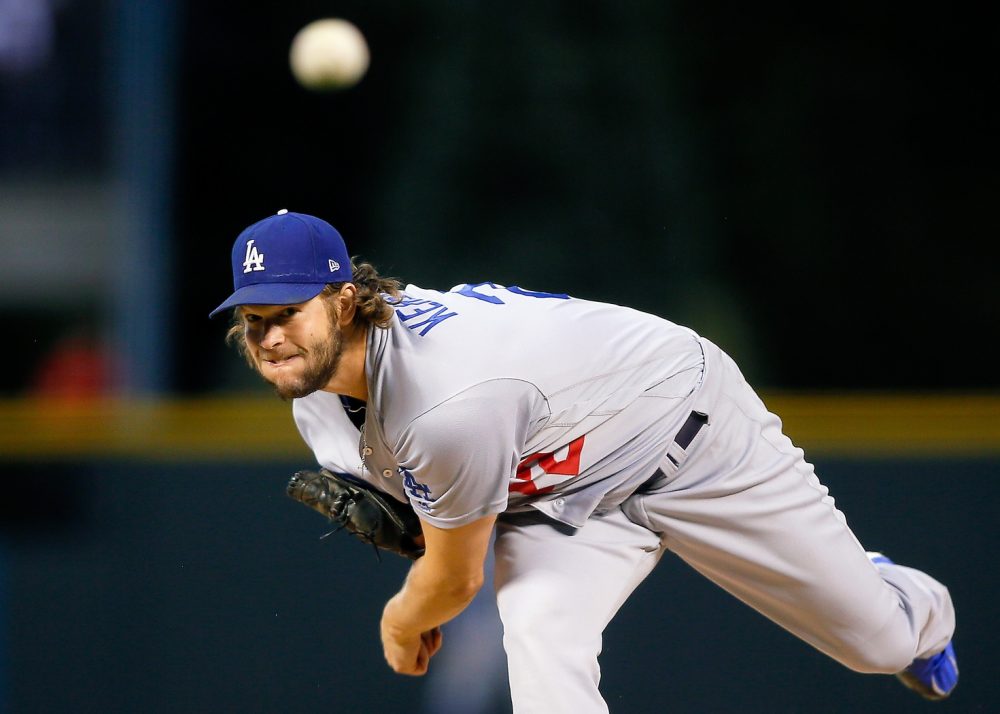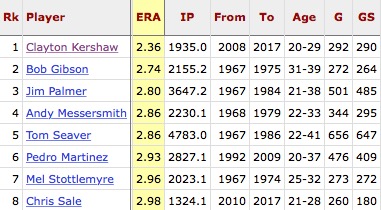
Player Background
Selected by Los Angeles seventh overall in the 2006 MLB Draft out of Highland Park High School in Dallas, Texas; it took less than two years (May 25, 2008) for Kershaw to reach the major leagues at just 20 years old. In 292 career regular-season appearances (290 starts) since 2008, he owns a 2.36 ERA (2.73 DRA) with 2,120 strikeouts (9.9 K/9) and 507 walks (2.4 BB/9) over 1,935 innings of work. A seven-time All-Star, he’s won three Cy Young Awards (2011, ‘13, ‘14) and a National League Most Valuable Player Award (2014).
Over a two-year span, Kershaw posted the lowest ERA (1.83 in 2013 and 1.77 in 2014) by a starting pitcher (until Jake Arrieta and Kershaw’s teammate Zack Greinke also accomplished the feat in 2015) since Pedro Martinez posted a 1.74 ERA with Boston in 2000. Kershaw’s was the lowest ERA for an NL starter since Greg Maddux recorded an absurd 1.63 mark with Atlanta in 1995. According to the Baseball-Reference Play Index, the 29-year-old southpaw’s 2.36 career ERA is the lowest of any starting pitcher in the last half century.

That’s pretty, pretty good.
2017: What Went Right?
Despite Kershaw allowing more home runs (23) than in any previous season of his career, fantasy owners were treated to another vintage Kershaw performance. Over a 21-start stretch to begin the season, he went 15-2 with a major-league leading 2.04 ERA and a 168-24 strikeout-to-walk ratio over 141 1/3 innings. Unfortunately, the white-hot run came to a screeching halt when he exited a start July 23 against Atlanta after just two innings. The reported lower back strain kept him out nearly six weeks, until he finally returned to the Dodgers rotation on Sept. 1.
2017: What Went Wrong?
After making at least 30 starts in six of his first eight seasons dating to 2008, Kershaw failed to do so for the second consecutive campaign, missing another significant chunk of time due to back issues. We’ll take a deeper dive into the long-term implications of Kershaw’s health issues later on. From an on-field performance standpoint, he wasn’t his usual dominant self once he returned from the disabled list in early September.
| Date | GS | IP | ERA | K/9 | BB/9 | HR/9 | BABIP | GB% |
| Pre-Sept. 1 | 21 | 141 | 2.04 | 10.7 | 1.5 | 1.2 | .251 | 47% |
| Post-Sept. 1 | 6 | 34 | 3.48 | 9.1 | 1.6 | 1.3 | .323 | 50% |
A large percentage of his late-season struggles can be attributed to bad luck on batted balls, but he also experienced a noticeable decline in strikeouts, while also serving up five home runs during that stretch. There still hasn’t been a clear-cut explanation given for his issues (and it was an extremely small, six-start sample), so it’s probably best not to draw a ton of conclusions. Aside from the uptick in home runs allowed (which can partially be attributed to the #juiced baseball) and some of the issues he had with his slider in April and May, there isn’t a lot to quibble about with Kershaw. He’s still the G.O.A.T.
2018: Outlook & Dynasty Value
There is a built-in arbitrary way in which we dissect the performance of a generational talent like Kershaw. The fact that he gave up his first career grand slam dominated an entire late September news cycle. Even a slight decline in his performance, or a worrisome trend, becomes immediately noticeable and scrutinized by baseball analysts. I get it. Therefore, I want to issue a quick disclaimer: Barring an unexpected major-injury development during the impending offseason, Kershaw will be one of the top three-to-five pitchers off the board in snake drafts next spring. There is an unimpeachable case that after nearly a decade of Hall of Fame caliber performance (when healthy), Kershaw is one of the safest investments in fantasy baseball, worthy of a hefty first-round investment.
However, I think there is a valid counterpoint that his recurring back issues are now an even greater concern that cap his fantasy upside moving forward. Even if we ignore his late-season swoon, the ceiling may no longer be high enough not to justify such a lofty ADP or auction bid in 2018. I realize how controversial this stance might seem on the surface. Just so that we are clear, I am not labeling Kershaw a potential bust. In fact, I think he still possesses the highest floor of any pitcher in baseball. I’m merely saying that I think his realistic ceiling or “upside” is no longer as high as the other elite fantasy aces like Chris Sale, Max Scherzer and Corey Kluber.
According to extensive research by BP’s Russell Carleton, “It’s clear that the biggest risk factor for injury is previous injury.” A pre-existing condition, like Kershaw’s persistent back problems, only amplifies the risk. According to Carleton, “a previous DL trip makes a pitcher about eight times more likely to land on the DL” in the same or following season. It’s entirely possible that Kershaw stays 100 percent healthy and avoids the disabled list next season. However, after two straight years of lower back issues (and a lengthy World Series run), projecting a return to 200-plus innings just seems unrealistic.
As my esteemed colleagues Mike Gianella and Mark Barry discussed with me on the latest episode of the Flags Fly Forever podcast, Kershaw’s injury (and workload) concerns are mitigated by the precipitous decline in starting pitcher workloads over the last decade. Per Baseball-Reference, only 15 individual starters eclipsed the lofty 200-inning plateau in each of the past two seasons.
Innings Pitched by Starters, 2008-2017
| Year | 200+ |
175+ |
150+ |
| 2017 | 15 | 42 | 75 |
| 2016 | 15 | 58 | 84 |
| 2015 | 28 | 64 | 89 |
| 2014 | 34 | 72 | 102 |
| 2013 | 36 | 70 | 96 |
| 2012 | 31 | 74 | 99 |
| 2011 | 39 | 76 | 107 |
| 2010 | 45 | 78 | 103 |
| 2009 | 36 | 66 | 87 |
| 2008 | 34 | 73 | 100 |
The 200-inning workhorse (like Kershaw used to be) is an endangered species on the brink of extinction. Yet, the greater concern for fantasy owners should be the fact that only 75 starters reached the 150-inning threshold last season. This universal trend isn’t going away for several reasons. Not only are modern front offices and managers placing greater emphasis on utilizing expanded bullpens filled with specialists, but also the 10-day disabled list enables them to be extremely cautious with minor injuries.
Simply put, Kershaw doesn’t need to throw 200 innings to remain one of the most valuable pitchers in fantasy baseball. According to Mike Gianella’s retrospective player valuations, Kershaw missed six weeks and still managed to finish as the second-highest earning pitcher ($36) in NL-only formats this season. There is a legitimate cause for concern with his back issues long-term, but when healthy enough to pitch, Kershaw still brings home the bacon.
Thank you for reading
This is a free article. If you enjoyed it, consider subscribing to Baseball Prospectus. Subscriptions support ongoing public baseball research and analysis in an increasingly proprietary environment.
Subscribe now